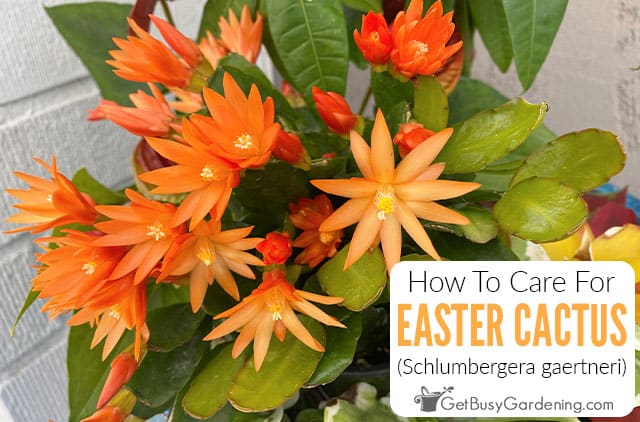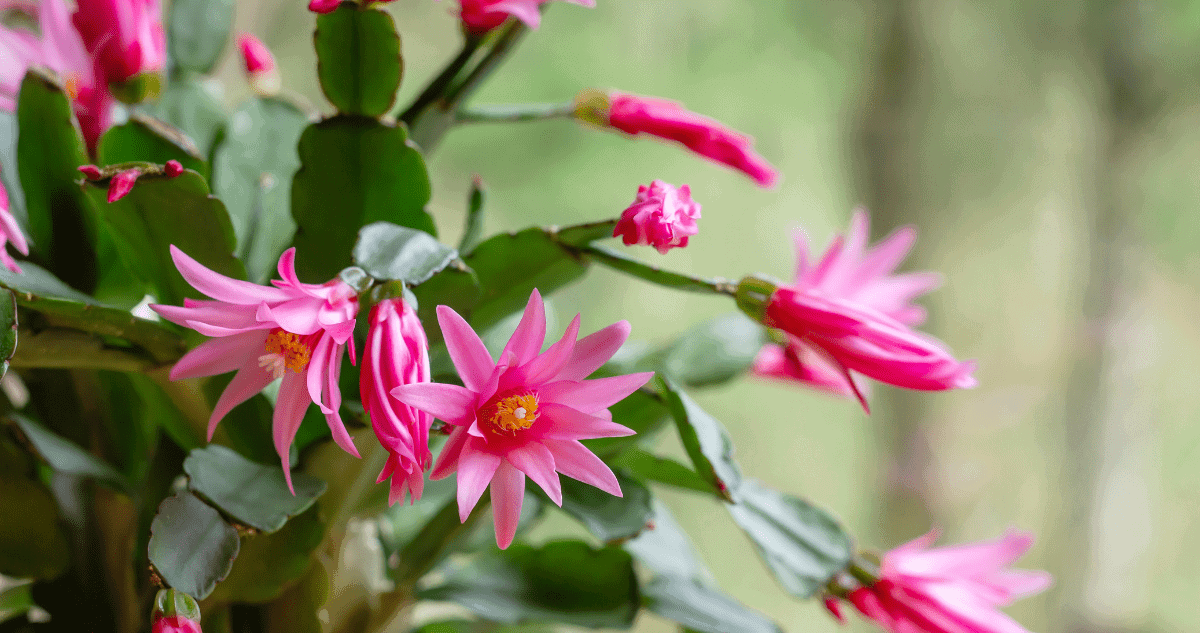To care for an Easter Cactus, provide it with bright but indirect light, keep the soil evenly moist, and maintain a consistent temperature between 65°F and 75°F. In the spring and summer, fertilize the plant every four to six weeks with a balanced houseplant fertilizer.
Understanding About Easter Cactus
Discover the essentials of Easter Cactus care to ensure its proper growth. Learn about watering, lighting, temperature, and other crucial factors to keep your Easter Cactus thriving.
Understanding Easter Cactus Easter Cactus, scientifically known as Hatiora gaertneri, is a stunning flowering plant that belongs to the cactus family. It is an attractive addition to any indoor garden due to its vibrant blooms and unique foliage. We will explore what an Easter Cactus is and its key differences from the popular Christmas Cactus.
What Is An Easter Cactus?
The Easter Cactus is a native of Brazil and is named after its blooming period, which usually falls around the Easter season. This cactus typically has segmented, flattened stems with small, spiny teeth along the edges. Its green to dark green flat stems have a cascading or hanging growth habit, making it a popular choice for hanging baskets or shelf displays. This cactus species is prized for its eye-catching flowers in shades of red, pink, purple, or white. The blooms are tubular and consist of several layers of petals, creating a striking display. The flowering period can last several weeks, providing a welcome burst of colour during spring.
Easter Cactus Vs. Christmas Cactus
While Easter Cacti and Christmas Cacti share some similarities, they can be differentiated by their key characteristics. Here’s a quick comparison between the two:
| Easter Cactus | Christmas Cactus |
|---|---|
| The stems of Easter Cactus have a more flattened appearance. | The stems of the Christmas Cactus are rounded and segmented. |
| Easter Cactus blooms around the Easter season. | Christmas Cactus bloom around the Christmas season. |
| The flowers of the Easter Cactus have a tubular shape. | The flowers of Christmas Cactus have a more star-like appearance. |
| Easter cacti prefer slightly cooler temperatures. | Christmas Cactus thrives in warmer conditions. |
Understanding the distinctions between Easter Cactus and Christmas Cactus is essential for proper care and maintenance. By knowing the specific needs of your plant, you can ensure it thrives and produces beautiful blooms for years to come. Now that we have explored the basics of Easter Cactus, let’s delve into the care requirements to keep your plant healthy and flourishing.

Credit: getbusygardening.com
Optimal Growing Conditions
Providing optimal growing conditions is essential for the health and vitality of your Easter Cactus. By understanding the specific temperature and humidity needs, light requirements, and ideal soil and potting mix, you can ensure your plant thrives and produces stunning blooms. Let’s take a closer look at each of these factors to help you provide the best care for your Easter Cactus.
Temperature And Humidity Range for Easter Cactus
Easter Cacti prefer temperatures ranging from 60°F to 70°F (15°C to 21°C) during the day, with slightly cooler temperatures at night. These cacti are native to the rainforests of Brazil, so they enjoy a more humid environment than other cactus varieties. Maintaining a humidity level between 50% and 60% is beneficial for optimal growth. You can increase humidity around your Easter Cactus by using a humidifier or placing a tray filled with water near the plant. Avoid exposing the cactus to extreme temperature fluctuations or drafts, as it can negatively affect its health.
Light Requirements
Easter Cacti thrive in bright yet indirect light. Place your plant near a north or east-facing window where it can receive a few hours of morning sun. Avoid exposing the cactus to direct sunlight, especially during the hottest parts of the day, as this can lead to sunburn or damage to the leaves. If you don’t have access to a suitable window, you can also use fluorescent grow lights placed a few feet above the plant to provide adequate light. Remember, finding the right balance is crucial as too little light can result in sparse growth while too much can cause leaf discoloration.
Soil And Potting Mix
Choosing the right soil and potting mix is crucial for the health and overall growth of your Easter Cactus. These plants prefer a well-draining soil that holds moisture without becoming overly soggy. A recommended mixture is one part potting soil, one part sand, and one part perlite or vermiculite. This combination ensures proper drainage and prevents waterlogged roots. Additionally, you can add a small amount of well-rotted organic matter to the mix to provide some extra nutrients for your cactus. When repotting, choose a pot that allows for growth while providing enough space for the roots to spread comfortably.
| Temperature | Humidity | Light | Soil and Potting Mix |
|---|---|---|---|
| 60°F to 70°F (15°C to 21°C) | 50% to 60% | Indirect bright light | Well-draining mix with potting soil, sand, perlite/vermiculite, and organic matter (in small amounts) |
Providing optimal growing conditions, including appropriate temperature, humidity, light, and soil, is paramount to the success of your Easter Cactus. Adhering to these guidelines will ensure that your plant remains healthy and able to showcase its beautiful flowers for years to come.
Proper Care And Maintenance
Proper care and maintenance are essential to keep your Easter cactus healthy and thriving. By following a few simple practices, you can ensure that your plant blooms beautifully year after year. In this guide, we will discuss the key aspects of caring for your Easter cactus, including watering and fertilizing, pruning and shaping, and pest and disease control.
Watering And Fertilizing
Watering and fertilizing are crucial for the overall health of your Easter cactus. These practices help maintain the moisture levels, provide essential nutrients, and contribute to its blooming cycle.
1. Watering:
When it comes to watering your Easter cactus, finding the right balance is key. Avoid overwatering, as it can lead to root rot and other issues. Instead, aim for a consistency that keeps the soil lightly moist but not overly saturated.
It is recommended to check the moisture level of the soil using your finger. If the top inch of the soil feels dry to the touch, it’s time to water. Ensure that the water drains freely from the bottom of the pot to prevent waterlogging.
2. Fertilizing:
Regular fertilization is important to provide your Easter cactus with the necessary nutrients for healthy growth and vibrant blooms. Use a balanced fertilizer specifically formulated for cacti and succulents, following the instructions on the package.
Typically, fertilizing once a month during the growing season (spring and summer) is sufficient. However, reduce or stop fertilization during the dormant period (fall and winter) to allow the plant to rest.
Pruning And Shaping
Pruning and shaping play a vital role in maintaining the attractive appearance of your Easter cactus and promoting its overall health.
Regular pruning helps remove dead or damaged parts of the plant, encouraging new growth and preventing the spread of diseases. Additionally, shaping your Easter cactus through pruning helps maintain a desirable shape and size.
To prune your Easter cactus, use clean and sharp pruning shears. Trim any dead or wilted stems, and cut back branches that have become too leggy or overcrowded. Aim for a balanced and symmetrical shape, but be careful not to remove more than one-third of the plant at a time.
Pest And Disease Control
Keeping your Easter cactus free from pests and diseases is crucial for its well-being. While these plants generally resist common pests and diseases, it’s still important to be vigilant and take necessary precautions.
Inspect your Easter cactus regularly for signs of pests such as mealybugs or spider mites. If you notice any infestation, gently wash the affected areas with a gentle soap and water solution or treat with an appropriate insecticide.
To prevent diseases, ensure your plant is placed in well-ventilated areas with good air circulation. Avoid overwatering, as it can lead to fungal growth. If you spot any signs of disease, such as wilting or discolouration, promptly address the issue by adjusting the watering habits or using disease-specific treatments.
By following these care and maintenance tips for your Easter cactus, you can enjoy its stunning blooms and lush foliage throughout the year. Remember to provide adequate watering and fertilizing, prune and shape the plant regularly, and keep an eye out for any potential pest or disease issues. With a little effort, your Easter cactus will thrive and bring beauty to your indoor or outdoor space.
:max_bytes(150000):strip_icc()/GettyImages-1311146228-2000-3b3b3f055575424bb0025419fb851e47.jpg)
Credit: www.southernliving.com

Credit: www.farmersalmanac.com
Frequently Asked Questions For Easter Cactus Care
How Often Should I Water My Easter Cactus?
Water your Easter cactus every 7-10 days, allowing the top inch of soil to dry out between waterings. Overwatering can lead to root rot, so it’s important to strike a balance and not let the plant sit in soggy soil.
Can I Keep My Easter Cactus Outdoors?
While Easter cacti can thrive outdoors in mild climates, they are primarily indoor plants. If you choose to move your Easter cactus outdoors, make sure it is not exposed to direct sunlight, as that can scorch the leaves.
How Do I Encourage My Easter Cactus To Bloom?
To encourage blooming, place your Easter cactus in a cool, dark location for 12-14 hours each night for about six weeks. This mimics its natural habitat and prompts the plant to set buds. Once buds form, return the cactus to its normal location and enjoy the beautiful blooms.
Conclusion
Taking care of your Easter cactus is essential to ensure its vibrant and healthy growth. By providing the right amount of light, temperature, and watering, you can help your cactus thrive. Remember to fertilize it during the growing season and prune it when necessary.
With these simple tips, you can enjoy the beauty of your Easter cactus all year round. Happy gardening!
